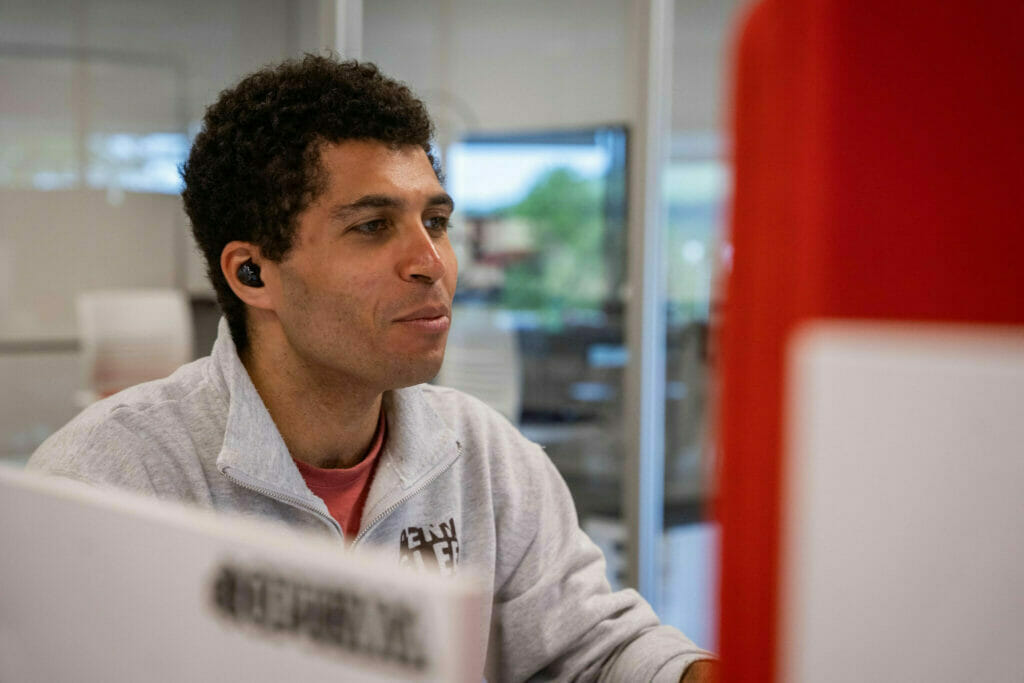It doesn’t matter how confident or capable you are; starting a new job has a way of taking you back to that awkward first-day-of-school feeling.
Will I fit in? What if they don’t like me? Will I hate it here? What if I’m not good enough?
Even if a new employee is excited to join your team, it’s very likely they have some anxiety about getting started. An effective employee onboarding process can alleviate those fears while also helping human resources professionals streamline the logistics of adding a new employee to your organization.
Why onboard new employees?
Although you could technically point a new team member to their desk (or ship them a laptop, if they’re remote) and have their manager check in to outline expectations, the lack of guidance would likely create an unpleasant employee experience.
Onboarding involves a long list of tasks and responsibilities that extend well beyond the first week. At a minimum, new employee onboarding includes:
- Establishing a start date
- Arranging a productive workspace
- Collecting new hire paperwork
- Providing information about company policies and benefits
- Requesting access to necessary equipment, software, and apps
- Making introductions and opening lines of communication between co-workers
- Helping new employees get familiar with their new work environment
- Setting up training
- Following up with your new hire
Implementing an onboarding workflow can help ease anxiety, increase efficiency, and ultimately improve employee confidence and productivity.
Learn more:

Why efficient employee onboarding matters
Onboarding is the first real interaction a new hire will have with your organization, post-hiring process. An employee’s initial 14 days on the job can leave an impression that’ll determine their productivity for weeks, months, or even years to come. So, it’s important to make that impression a great one.
Hiring tends to be expensive and time-consuming, especially in a competitive job market where many companies are fighting for the same top talent. When you fail to invest in effective onboarding, it can make your company appear disorganized, uninviting, and out of touch. At worst, a poor onboarding experience can drive a candidate you landed to leave in pursuit of the next best offer.
Conversely, a warm, welcoming onboarding experience will empower new employees while illustrating your company culture and core values. Investing time and energy into onboarding can pay long-lasting dividends in terms of employee engagement, workplace positivity, improved retention rates, and more cohesive, collaborative teams.
Aside from putting your best foot forward as an organization, having a comprehensive program for new hire onboarding makes the lives of hiring managers and HR professionals so much easier. No more tracking down paperwork or realizing that someone forgot to order equipment for a new employee. Small inconveniences add up to big chunks of time that could be spent more productively.
An effective onboarding process also helps ensure compliance with industry or government guidelines or regulations, which reduces the risk of legal liability in the future—something no one wants to deal with.
Learn more:
What is employee onboarding?
Employee onboarding is the set of tasks and procedures initiated after a candidate is hired to integrate them into the organization and prepare them for their new role.
Onboarding includes the logistical tasks traditionally managed by HR, such as issuing the employee handbook, arranging compensation and benefits, ordering equipment, scheduling a start date, making introductions, and organizing training efforts.
However, onboarding involves more than just administrative tasks; it also covers everything involved with teaching a new employee the basics of their new position and helping them adjust to your organization’s culture and values.
Good employee onboarding covers the entire employee lifecycle, including everything from a new hire’s first 30 days to long-term career pathing and leadership development. It’s an ongoing process that tends to last upward of a full year. In fact, at many great companies, the idea of onboarding never ends—there’s always something new worth learning.
When does the onboarding process start?
It’s common to think that onboarding begins on an employee’s first day at work, but day one of onboarding should actually start during the hiring process, upon the acceptance of a job offer.
Starting the employee onboarding experience before a person’s first day at work helps familiarize them with your organization’s culture and policies. As a result, they’ll feel more prepared, confident, and comfortable around new colleagues during their first week at work. Providing that extra time to ease anxiety and reduce the possibility of logistical hiccups helps new team members get to a point where they can work effectively and independently far more quickly.
Learn more:

The different types of onboarding programs
The specifics of your onboarding program may vary depending on the size of your organization or the type of position being filled. There are generally five elements of onboarding:
Operational onboarding
Operational onboarding involves arranging and/or assembling the equipment an employee needs for their job, including workspace supplies, hardware, software, and login information.
Knowledge onboarding
Knowledge onboarding is the provision of training or mentorship that conveys the knowledge needed to perform the daily tasks and responsibilities of the role.
Performance onboarding
Performance onboarding involves setting short-term goals and actions for new hires, then providing feedback to help them accomplish those objectives.
Social onboarding
Social onboarding is all about making new hires feel welcome. This can range from sending a celebratory first-day care package to pairing them with an onboarding buddy to help them transition into their role.
Talent onboarding
Talent onboarding is part of the talent optimization process. By understanding the skills, knowledge, and prior experiences of new team members, you’ll enable greater team building while identifying future growth opportunities for them within your organization.
How to onboard new employees
Your onboarding process should include elements of all the different onboarding types listed in the previous section. Just as important, however, is how you pace your onboarding experience.
Here’s an onboarding timeline you can use when bringing new hires into the fold:
First day
Ideally, on an employee’s first day, the majority of their operational onboarding has already been arranged. The focus, therefore, should be on the social component—making sure you properly introduce them within the organization. Avoid overwhelming new hires with an avalanche of information and focus on being friendly, welcoming, and covering the basics.
Show them their workspace, give them a tour of the building (or a virtual tour, if remote), provide an onboarding schedule, and introduce them to their managers and colleagues. Keep the day structured so that they know what to expect, but treat it more like an informational overview of your organization and their position within it.
First three months
Knowledge onboarding happens primarily within the first three months as new hires learn the ins and outs of their job. Arrange for their training, and set up your new employee with a mentor or supervisor who can support them as they put their skills to work in their new position.
The first three months should also include some aspects of performance onboarding. Management should set up regular check-ins to offer feedback and help outline new initiatives and performance goals.
First year
Performance and talent onboarding are prioritized in this latter stage, as your new hire shifts from the introductory phase to working independently in their role.
Set and review performance goals and make a note of any skills, experience, or behavioral characteristics that could fulfill other needs or future roles within the organization. As you do so, assess if any additional training is needed to help your employee rise to the occasion.
Learn more:
- How to build a successful employee onboarding program
- Download our onboarding slides to help educate new hires.

Best practices for developing an onboarding process
An effective onboarding strategy involves creating a workflow that can be scaled up and repeated for future new-hire cohorts. The more you invest in a repeatable onboarding process, the more consistent—and sustainable—your overall talent strategy becomes.
Consider the following best practices as you come up with a plan:
Automate your workflow.
Employee onboarding software is a helpful onboarding tool that can automate time-intensive tasks and keep the entire process organized for everyone involved. If you don’t use onboarding software, create an onboarding checklist to allow for greater consistency.
Make it personalized.
A routine workflow is important, but don’t let it sacrifice the personal touches that make new candidates feel special and welcome. Send a personal welcome email or package to show new hires that you’re excited that they’re joining your company, and not just glad the role is filled.
Allow for introductions.
Give a heads-up to your team ahead of a new hire’s start date, and provide a brief bio so everyone can learn about their new teammate. When introducing your hire to the team, allow ample free time so they can get to know everyone in more than a cursory “Nice to meet you” way.
Codify your company policies.
New hires are usually overwhelmed with information as they start a new job. Create an easily accessible resource that includes information about core values, company policies, benefits, payroll, and anything else relevant to working for your organization.
Plan a team activity.
Connection helps inspire collaboration. Organize social gatherings or team activities to help team members get to know each other. In doing so, you’ll build cohesion, encourage teamwork, and inspire your team to achieve its next milestone.
Provide the necessary tools.
Providing new hires with the tools and equipment they need to work effectively is critical to their success. Eliminate the inconvenience of waiting or chasing down login info by making sure new hires have everything they need to work from day one.
Avoid isolation.
Pairing new hires up with an onboarding buddy can make their first days on the job easier to navigate. An onboarding buddy serves as a point of contact for any questions or concerns and helps new team members feel more connected and comfortable in the workplace.
Follow up.
Encourage members of your HR or People Ops team to follow up with new employees. In doing so, they can verify that new hires have everything they need, collect feedback on their onboarding experience, and ensure a smooth transition from new hire to tenured employee.
Measure onboarding metrics.
Collecting and reviewing onboarding metrics provides a data-driven look into your onboarding program’s effectiveness. Discover any bottlenecks, refine your process, and improve retention rates with data collected from surveys, performance reviews, or employee onboarding software.
Learn more about building the best onboarding process:
- Make onboarding a team effort.
- What’s missing from your onboarding: Lessons from 3 top employers
- Three ways to onboard new employees during your busiest season
- How I improved onboarding on my team
- Successful onboarding using The Predictive Index
- How to ensure new hires aren’t drowning in your onboarding
- How to design your employee onboarding process
Onboarding of virtual and remote teams
Onboarding virtual employees presents an entirely unique set of challenges for hiring teams. Yet, overcoming those obstacles is more important than ever given the rise of remote work.
Among the most pressing challenges are 1) ensuring new hires feel fully informed and properly supported, and 2) fostering an environment that inspires connection and collaboration. Both are more difficult without the ability to stop by someone’s desk or run into a colleague when refilling your coffee mug in the breakroom.
Thankfully, there are plenty of options that can help you overcome the limitations of remote work, including:
- Setting up new hires with an onboarding buddy
- Facilitating regular video conferences and video Q&As
- Planning virtual social opportunities that encourage casual chats
- Implementing an online communication channel like Slack
Learn how to make a virtual onboarding checklist:
The importance of the employee onboarding process
Welcoming new employees to your organization, familiarizing them with their role, and checking the boxes of logistical to-do lists are all essential to getting a new team member up and running.
Employee onboarding has additional, quantifiable benefits, though, including the following findings from Gallup’s “Creating an Exceptional Onboarding Journey for New Employees” report:
It increases employee retention.
According to data collected for the above-mentioned report, companies with a formal onboarding program could experience a 50% increase in new hire retention.
It boosts employee productivity.
Employees who had a positive onboarding experience were 62% more productive than new recruits in the same group who did not report a good onboarding experience.
It improves employee satisfaction.
The Gallup report revealed that new hires who had a positive onboarding experience were almost three times more likely to report that they felt prepared for, and supported in, their new role.
It enhances your brand.
One surprising finding of the Gallup report is that only 12% of employees surveyed felt their company has an effective onboarding program. However, employees with an exceptional onboarding experience were 2.6 times as likely to feel extremely satisfied with their workplace.
It demonstrates good communication.
Employees who answered that they “strongly agree” that they had a good understanding of how things are done within the organization were 4.7 times more likely to report their onboarding experience as exceptional.
It builds company culture.
As stated in the report, “Onboarding is the first chance organizations have to demonstrate their real culture, putting into action the culture they claimed to have in their attraction and hiring interactions with candidates.”
Build trust by bringing your core values and company culture to life with a thoughtful onboarding experience. In doing so, you’ll empower your employees to embrace their new positions with energy and confidence.
Learn more about the importance of onboarding:
- The onboarding guide for new sales hires
- How Slack builds culture during onboarding
- Guidelines for successful onboarding
- The close ties between onboarding and employee engagement
- 5 ways to build confidence in a new hire
Level up your onboarding with PI.
Not all onboarding experiences are created equal. The best ones take care, intention, and energy from everyone involved.
The Predictive Index makes onboarding easy for hiring and HR teams alike. While PI is well-known for its trusted pre-hire assessments, it also offers a variety of powerful post-hiring tools to make onboarding a breeze.
- Use PI Hire to identify the right talent for a role using millions of hiring data points.
- Build supportive manager-employee relationships with the help of PI Inspire.
- Showcase a new hire’s strengths within their team by leveraging PI Design.
- Run PI Diagnose to ensure new hires stay engaged for months and years to come.
With PI, give your new hires the all-star welcome they deserve.


